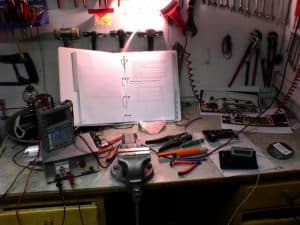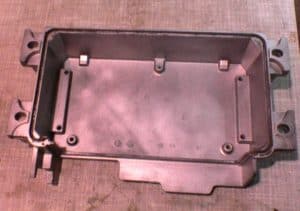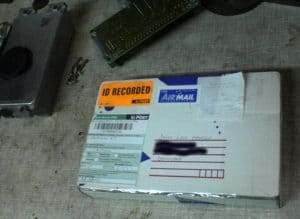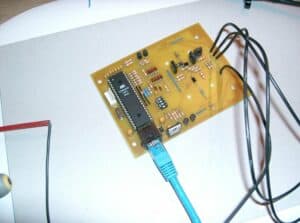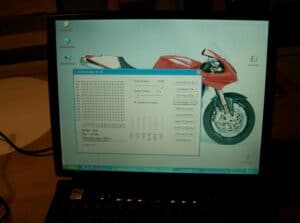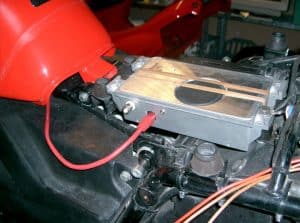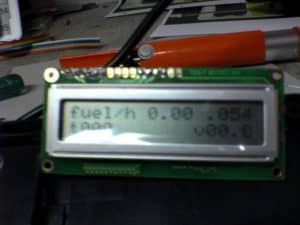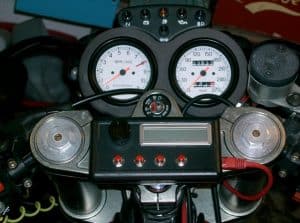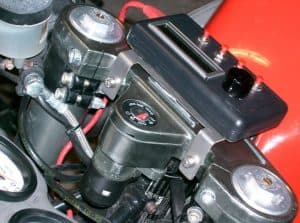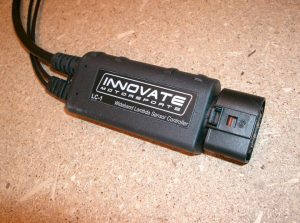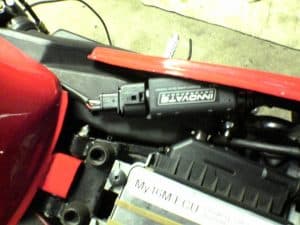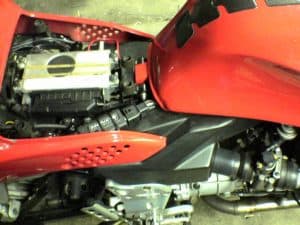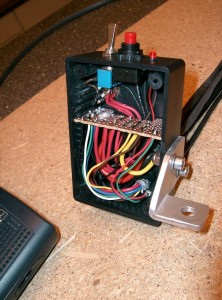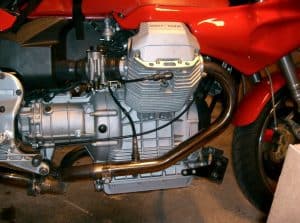Building a My16M Fuel Injection ECU.
When you're not satisfied with the performance of the Weber Marelli 16M ECU, you have a number of opportunities:
-
Adjust TPS, low range mixture pot-meter, bypass valves, and balance till you drop.
-
Buy a different EPROM
-
Install an extra black box (Power Commander or equivalent) to alter the injection signal, and maybe the ignition timing.
-
Ditch the Weber Marelli, and install a third party ECU.
I tried the adjustment fix, but I was never quite satisfied with the result, it still had the occasional misfire at 3500-4000 RPM, and the idle was never as stable as on my old Le Mans with 40mm Dell Orto's.
Another EPROM is a quick and cheap thing to try, but you simply don't know what you get. You have to be very naive to think that just because the little black bug is named (High Speed Tuning Chip) it'll solve all your problems. And even if it does work to your satisfaction, its no good any more if you install the loud carbon cans, or throw in another cam, or….. The EPROM way didn't seem to be the solution to me.
The Power Commander was actually considered as its a well known product, doing a lot of good for a lot of bikes. The only negative side is that installing a Power Commander, gives you an extra black box that's hard to diagnose if your bike is acting up, and absolutely impossible to repair on your own. This is an important issue to me as I was having several considerations about buying a F.I. bike – I do not fancy black boxes, I like to be able to fix my bike my self. (Yep, I'm a stubborn, old fashioned fundamentalist)
As for third party ECU's (Only Weber Marelli 16M), I already knew about two suppliers (Moto Spezial, and HT Moto. Both German). Unfortunately both were very expensive and absolutely out of financial range. Period.
Hang on, I'm getting to the point now!! On one of the Moto Guzzi forums, I learned about the My16M ECU, developed in Australia by Cliff Jefferies.
Now, this was interesting – every one was praising the My16M, and it had a very comprehensive set of features:
-
It will fit into an original WM16M box (providing you remove the original PCboard) – this means that you don't have to alter the original wiring, and you can keep the original WM box as a spare if you prefer.
-
You can buy it assembled or as a kit – hardware is open, allowing you to fix it yourself if it breaks.
-
All parameters can be changed with a PC program and a standard RJ45 network cable. Maps are stored as files on the PC and can be loaded into the ECU quickly.
-
You can even change maps while riding using the optional Optimizer box.
-
Diagnostics tool allows you to check the input of all sensors.
-
Install an O2 sensor (Narrow or wide band), and let the ECU go closed loop. (Automatic change of mixture depending on feed back from O2 sensor)
-
Very reasonable prices.
OK, you guessed it, I bought the kit + optimizer + a dead WM16M ECU from eBay.
Depending on your electronic skills, building a kit like this may be easy to you, but to me it was a real challenge. I have a technical education that included some electronic knowledge, but I haven't done any soldering the last 15 years.
I'm aware that most failures in electronic equipment is due to mechanical stress, so I used very much time to make everything fit properly into the boxes.
I had a few problems building the kit, mainly due to the information on Cliffs web site not showing the latest version, but Cliff provided excellent and fast support on all my questions.
After finishing the My16M and optimiser kit, I had the bike started a few times, and everything seemed to work. But it was still winter in Denmark, and I had to show a little patience for a couple of month, before I could start testing/tuning.
________________________
From narrow band to wide band sensor.
I finished the assembly of the bike, had a friend of mine welding a stainless bung for the O2 Sensor into the right header pipe, and installed the O2 sensor. After starting the bike a few more times, it was obvious that the cheap narrow band sensor was far too digital in behavior to be of any real use. So I decided to go wide-band and started the search for the right product. My choice was the LC-1 unit from Innovate motorsports. (Europeans should buy from German LM-1.com for better prices and excellent support)
The narrow band sensor will connect directly to the My16M, but the wide band unit is a bit more complicated. It consists of the sensor, a programmable controller unit, and few external items (pushbutton, and LED for calibration and error codes).
I had to find a location for the controller, and found out that it would fit under the seat, but only if I angled and tilted it just right. An aluminum bracket was made and I managed to squeeze the controller in place. This may sound easy, but it took several hours to get the bracket right.
The controller had quite a few wires (power, three grounding wires, programming, calibration, and two outputs), so I made up a small distribution box for wires, buttons and the LED. To be sure that the wires was properly connected, I soldered all wires to a small PC board in the box.
The LC-1 powered up, and I programmed the two outputs with no trouble at all. I really like the LC-1 unit – it works as it's supposed to and easy to set up.
________________________
Tuning sessions.
Finally, spring arrived in Denmark. I took the bike out started it, and synchronized the throttles. Ready to rock.
The bike was now smoother and much more pleasant in behavior than with the original WM box. That is, above 2000 RPM. It was really weird at idle: Sometimes it was fine, at other times it could cough and puff, or simply just stall. After a few days of belly scratching I finally found out why – inlet rubber manifolds not tightened properly !!! (Do not mention this to me – ever ! I'm a bit touchy on this subject…..)
During the first days of testing I made a few unintended adjustments while playing with the Optimiser, but with a little experience, I got the hang of it. No problem now.
Now the idle was stable once obtained, but if I just snapped the throttle closed from speed, the bike would stall every time. In other words, I had to "guide" the engine down to idle. After a few experiments, I found out that leaning the bottom row of the map about 10% did the trick.
So all in all, the My16M-optimiser-LC1 combo reacts nicely and correct to my changes in mapping, the challenge for me is now to learn which parameter to change to get the desired effect, and finding the right O2 targets for closed loop operation (I already run closed loop, but I'm not positively sure my O2 targets are correct).
For the first test rides, I brought the original WM ECU in a tank bag – just in case. But the My16M has been 100% stable from day one, so the WM box remains in my workshop now.
I still have a lot of testing and fine tuning to do, but I'm very, very satisfied with the performance of the My16M. And the pose value of the Optimiser box is tremendous 🙂
After 3 month.
I've done a number of small adjustments, and the result is even better now. With the original WM-ECU, I could go no lower than approx. 3500 RPM in top gear, now I can go all the way down to 2000 if I'm easy on the throttle. Not that I do this much, but it gives you an idea of the improvement in drivability.
I'm still playing around with settings, just for the fun of it, but my base map haven't changed mush the last couple of month. I haven't had any problems at all regarding stability or weird drop outs, so I'm still very very satisfied with the My16M + Optimiser + LC1 combo.
Building the My16M and accessories – the pics.
Pictures below will show the progress of building the My16M ECU, Optimizer, and LC-1 wideband sensor unit. Sorry for the quality of the pics, my cell phone camera is not that good for close-ups.
Dismantling dead Weber Marelli box (from a Ducati 916)
WM16M print
Bare box
Print and connector separated – connector can not be bought separately.
Kit arrives from Australia – Guess if I'm exited.
Content of package – having second thoughts on this project.
First fitting of PC-board to box.
Check if there's still room for the connector – note connector pins cast into epoxy glue to avoid breaking.
RS232 board for PC connection soldered and boxed.
Soldering main PC board.
Still soldering.
Will the connector still fit when all components are installed ?
First communications test (Wife not at home).
RJ45 cable and the necessary wires fitted ….
and we have communication 🙂
Lots of wires.
not much room.
But with a little patience everything fits nicely into the box. Note BNC connector to the left for O2 Sensor.
My16M installed to the bike, and it started right away…..
This is actually a later picture with the RJ45 cable for the optimizer in place
Building the Optimizer.
Wiring buttons and potentiometer.
Actually, modifying the plastic box for the optimizer involved a lot of time and belly scratching – I think the box was designed for a remote control.
First power up of the Optimizer – Proud of myself again.
Optimizer fitted to the bike.
Nice little bracket, ehh ?
LC-1 wideband controller.
Will probably fit in here….
… if I tilt, angle, and bend this little bracket for a couple of hours !!!
Yep, I'm proud – even the seat fits now 🙂
Power/signal distribution box for wideband controller.
LED for error codes, pushbutton for calibration, and toggle switch for choice of power supply (one for calibration, one for normal running).
Sensor, controller, and distribution box in test setup.
Distribution box installed under rear seat.
Location of O2 sensor.

